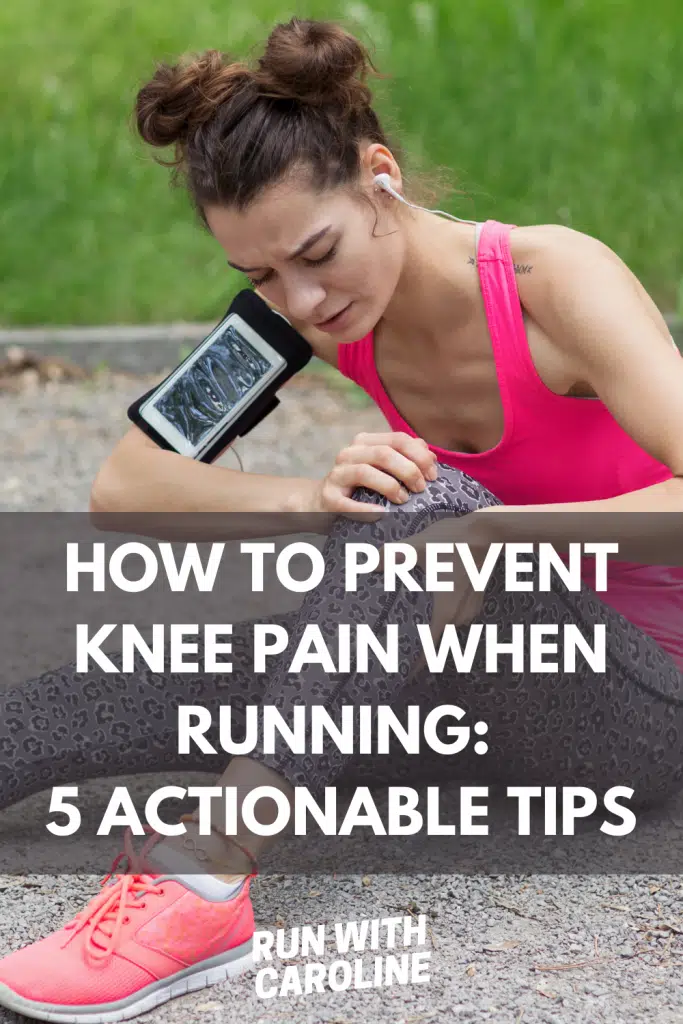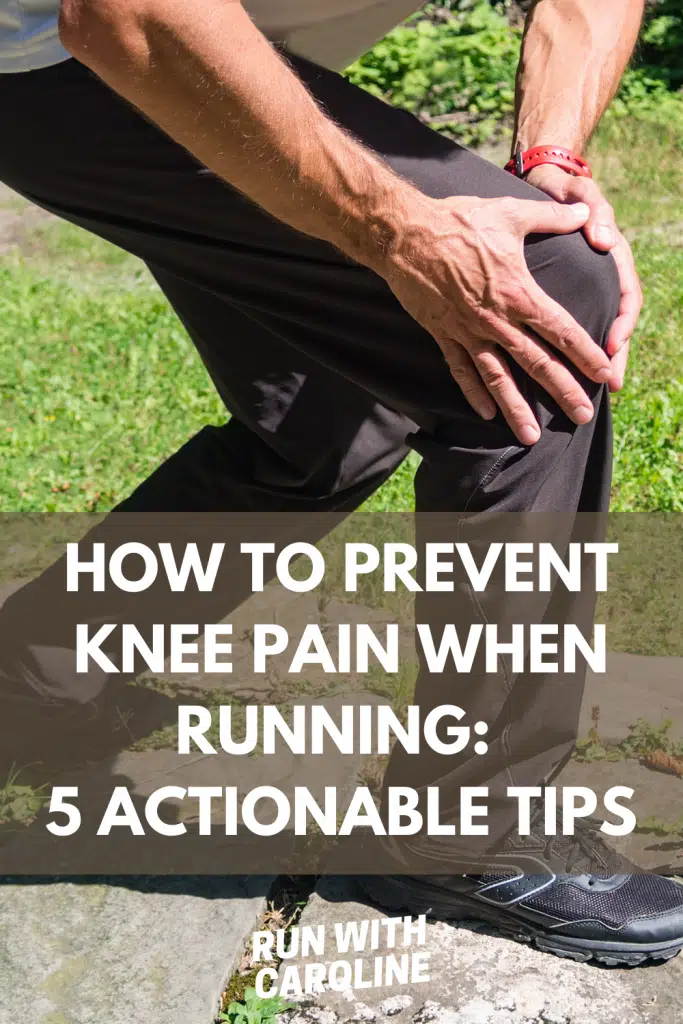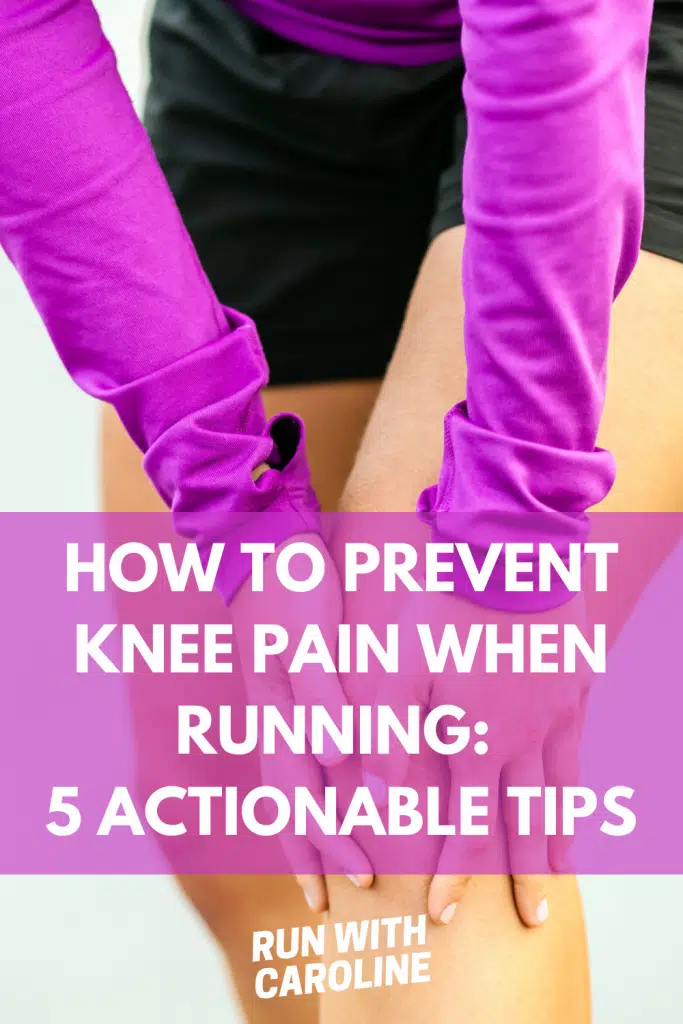Knee pain after running is one of the most common running injuries.
Unfortunately, the injury rate in the running community remains pretty high.
Knee injuries in particular account for 50% of all running injuries, according to a 2015 study.
Running is considered a repetitive, high impact form of exercise involving many muscles and joints, including the knee.
This can cause injuries over time if you don’t work on your running form or include activities like strength training in your training routine.
In this guide, we’ll look at:
- What causes knee pain after running?
- 5 injuries that cause knee pain after running
- How to treat knee pain after running
- How to prevent knee pain after running: 10 actionable tips
Ready?
Let’s get started!

What causes knee pain after running?
Contrary to what many people believe, running itself does not cause knee problems.
Instead, it’s the way you run that leads to pain and injury.
If you learn how to run properly using proper running form, where there is minimal impact or less stress on your joints, you will never have knee problems.
The following can also cause knee pain after running:
- Sudden increase in mileage
- Sudden increase in training frequency
- Weak glutes or hips
- Problems in your kinetic chain, such as muscle imbalances or structural issues
- Tight and stiff muscles
- Poor running form
- Ill-fitting running shoes
Related: Knee brace for running: When to wear one + where to buy
5 injuries that cause knee pain after running
Knee pain after running is often caused by injuries like runner’s knee, IT band syndrome and knee bursitis.
Let’s look at these injuries in more detail:
#1 Runner’s knee
Also known as patellofemoral pain syndrome, runner’s knee is the most common cause of knee pain after running.
When too much load is put on the knee, the tissues around the knee cap can become inflamed and irritated.
A common symptom of runner’s knee is pain in the knee cap, either when walking/running or when sitting down with your knees bent.
Runner’s knee can also be caused by tight muscles, poor running form and muscle imbalances.
#2 IT band syndrome
The IT band (or iliotibial band) is the band of connective tissue that runs from the hip joint to the knee joint.
Because running is a repetitive movement, this can sometimes cause friction in the IT band where it meets the knee and this can lead to tightness and inflammation.
IT band syndrome can also be caused by incorrect running form and weak hips and glutes.
#3 Meniscus tear
The meniscus is a piece of cartilage that sits between your shinbone and thighbone.
Meniscus tears are normally caused repetitive movement or activities involving twisting, like suddenly changing direction.
The symptoms of a meniscus tear are pain and inflammation around the knee which can make it hard to fully extend the knee.
#4 Jumper’s knee
Jumper’s knee (also known as patellar tendinitis) causes pain below the knee in the patellar tendon where the knee meets the shin.
The patellar tendon helps you extend your knee fully, and when additional stresses are placed upon it, it can become inflamed.
Patellar tendinitis is normally caused by sudden increases in running mileage or frequency.
#5 Knee bursitis
Located near the knee joint, there is a small fluid-filled sac called the bursae.
When the bursae becomes inflamed or irritated, it causes pain on the knee cap or just below the knee joint.
This is normally caused by a sudden increase in mileage or speed.
Related: What is runner’s knee? How to fix it + 6 prevention exercises

Related: Running with plantar fasciitis: Everything you need to know
How to treat knee pain after running
If you experience knee pain after running, the most important first step to take is to stop running.
From there onwards, follow these simple tips to treat knee pain after running:
#1 Apply cold ice packs
Ice packs applied to the knee will help to reduce any swelling and inflammation.
It is recommended you apply ice packs every 3 to 4 hours for 15-30 minutes at a time for a period of 2-3 days until the pain and swelling has gone.
#2 Elevate your leg
Elevate your leg when you sit down or lie down.
#3 Take pain medication
Take over the counter pain medication like ibuprofen or naproxen to help reduce the pain, inflammation and swelling.
If the pain becomes chronic, speak with your healthcare provider as more extensive rehab may be required.
#4 Rest
With any pain, it’s always good to have a period of rest before getting back into running.
Don’t be tempted to run through the pain as it could make the injury worse.
Also, try to avoid any activities that could make your knee pain worse, such as squatting, lunging, or sitting for long periods of time.
Related: How to recover after a bad run: 8 ways to bounce back

How to prevent knee pain after running: 10 actionable tips
#1 Review your footstrike
Your footstrike is the way your foot hits the ground.
You may have heard of a type of footstrike called heel footstrike which happens when you over-stride and you let your foot hit the ground ahead of you, past your knees.
This is problematic because every time your foot lands on the ground, it sends impact forces to your knees which are acting like shock absorbers.
Over time, all of this impact to your knees leads to joint pain and muscle soreness.
The best way to prevent knee pain when running is to try and avoid heel striking altogether.
Instead, adopt a mid-foot strike which is considered to be a happy medium and the most natural of footstrikes.
Mid-foot strike is characterised by the middle of the foot hitting the ground first.
As a result, your weight is distributed evenly throughout the foot and ankle, which reduces the rate at which impact forces travel up the leg.
Another good tip is to keep your feet aimed in the direction you are running.
Twisting your feet to the side every time you take a step forward will create unnecessary tension in your knee.
Related: Proper running footstrike and ways to improve it
#2 Keep your knees soft and bent when running
Many runners that over-stride tend to lift their knees out in front of them and then straighten their knees out as they land.
This in turn creates a lot of pressure which impacts the heel and knee as they run.
This sort of running form should only really be used for sprinting over short distances, and not for mid to long runs.
Keep your knees swinging low and at the end of each stride, bend your knees and let your heels float up behind you.
Related: 6 strength exercises to help prevent runner’s knee
#3 Increase your cadence
Linked to footstrike is cadence.
Whilst your footstrike is the way your foot hits the ground, your cadence is your stride rate, or in other words the number of steps you take per minute (SPM).
Like footstrike, cadence plays an important role when it comes to proper running form and can help to prevent knee pain after running.
When you increase your cadence, you will find it’s easier and feels more natural to place your foot underneath you – in your centre of gravity – instead of in front of your hips.
Next time you’re out for a run, imagine you are running on ice.
Take small strides and your stride rate will soon increase.
Related: 4 ways to improve your running cadence
#4 Strengthen your hips and glutes
Knee pain after running can be caused by problems above and below the knee cap.
Weak hips and lazy glutes are common causes of runner’s knee.
If you have weak hips or weak glutes, this means the knee joint has to cope with a lot more weight and pressure.
Over time, this causes the muscles in your knee to malfunction and eventually cause pain.
There are lots of exercises that you can do regularly as part of your training routine to help prevent knee pain.
Strength training is a vital part of becoming a stronger and faster runner, and they also help during recovery from a knee injury.
The following exercises target muscles that help align your hips and knees.
You can complete them purely as body weight exercises, or you can add weights or a resistance band to add resistance and make them a bit more challenging.
- Clams
- Hip bridges
- Donkey kickbacks
- Straight leg raises
- Side lying leg raises
- Bulgarian split squats
- Fire hydrants
- Low front lunges
Related: 7 of the best glute strengthening exercises for runners
#5 Stretch
Stretching helps to improve your flexibility and increase your mobility as a runner.
It also helps to improve circulation and increase blood flow to your muscles, which help to keep your muscles ready and prepared for your next run.
Many runners will tell you that running with tight and sore muscles is not fun.
This is why it’s important to have a stretching routine to help reduce muscle soreness after and in between runs.
Try stretches that target the major muscles in your legs such as your IT band, quads, hamstrings, abductors, glutes and calves.
Incorporate them in your warm up using dynamic stretches, or in your cool down using static stretches.
#6 Foam roll
As with stretching, foam rolling is a great way to improve circulation and blood flow to your muscles.
The other benefit to foam rolling is that it loosens up stiff muscles.
Muscle stiffness can impact your form when running. If you have tight glutes, for example, this can affect how you power your leg forward during a run.
According to a 2015 study, foam rolling has “short-term effects on increasing joint range of motion without negatively affecting muscle performance.
The study concludes that foam rolling may help to reduce DOMS (delayed onset muscle soreness) after intense exercise.
#7 Use shoe inserts
If you have imbalances in your feet, a good pair of shoe inserts will help to distribute the load of your step more evenly.
If you have flat feet, for example, you may benefit from shoe inserts to provide foot arch support.
Correcting a foot imbalance will improve your running posture and alignment and will help to prevent injuries in your knees and hips.
#8 Warm up before each run
The warm up is essential to get your body prepared for a run. It also helps to reduce the risk of injury.
A proper warm up should include light jogging as well as dynamic stretches. You may also want to include running form drills in your warm up.
#9 Wear supportive running shoes
The right pair of running shoes will do wonders for your running and athletic performance.
A good pair of running shoes will support your feet when your run and protect you against common running injuries like runner’s knee and shin splints.
They will also help to cushion your feet from heavy landings.
You can read more on finding the right running shoes in my running shoes guide.
#10 See a physical therapist
If your knee pain persists or becomes chronic, it’s a sign you need to see a healthcare professional such as a physical therapist.
A physical therapist will be able to provide you with expert advice on treating your knee pain.
They will recommend treatment options as well as a program of rehabilitation.
- 5 things I wish I’d known before returning to running - March 3, 2024
- Running 20 minutes a day: Benefits + how to start - January 27, 2024
- How to run your first 2 hour half marathon - January 16, 2024
